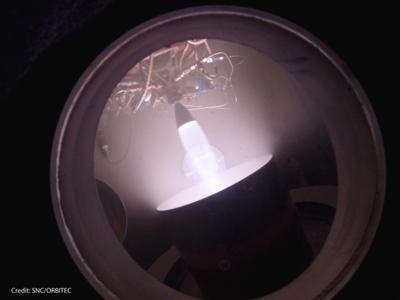Thu, Dec 04, 2014
Test Marks Completion Of CCiCap Milestone 15a
Sierra Nevada Corporation (SNC) has successfully completed a major milestone relating to the Reaction Control System (RCS) propulsion risk reduction for the Dream Chaser Space System, known as Milestone 15a. The achievement further matures the design toward Critical Design Review (CDR) and positions SNC one step closer to concluding all milestones laid out in NASA’s Commercial Crew Integrated Capability (CCiCap) agreement. According to a company news release, to date, SNC has received 96 percent of the total award value of the CCiCap agreement, having successfully completed 12 of 13 milestones.

Milestone 15a builds on SNC’s previous propulsion system innovation and development maturity by implementing a compact prototype thruster operating in a vacuum chamber to simulate an on-orbit environment. The RCS, which is being designed and tested by SNC’s wholly-owned subsidiary, Orbital Technologies Corporation (ORBITEC), provides precise on-orbit control of the Dream Chaser spacecraft for many critical maneuvers including docking of the Dream Chaser spacecraft to destinations in low-Earth orbit. The RCS also supports the unique capability of the Dream Chaser to safely return from orbit and land on any designated runway.
“Safety is paramount in the design of the Dream Chaser Space System,” said Mark N. Sirangelo, corporate vice president of SNC’s Space Systems. “It is driven by reliability, rigorous quality assurance, consistent performance, extensive testing, and robust analysis. In passing this milestone, we are able to validate our performance and safety, while decreasing the risk for this critical propulsion system. Reaching this milestone propels us even closer toward the Critical Design Review and orbital flight of our complete system.”
On August 19, 2013, SNC and NASA amended their original CCiCap Space Act Agreement to add Milestones 15a. The optional milestone provided critical hardware demonstration of the RCS technology to support crewed or uncrewed missions of the Dream Chaser Space System architecture.
(Image provided by Sierra Nevada Corp)
More News
Pilot Applied Full Aft Stick And Nose-Up Trim, But The Airplane Remained On The Runway Analysis: The pilot reported that a preflight inspection and flight control checks revealed n>[...]
A Few Questions AND Answers To Help You Get MORE Out of ANN! 1) I forgot my password. How do I find it? 1) Easy... click here and give us your e-mail address--we'll send it to you >[...]
From 2022 (YouTube Edition): Before They’re All Gone... Humankind has been messing about in airplanes for almost 120-years. In that time, thousands of aircraft representing i>[...]
Advanced Air Mobility (AAM) A transportation system that transports people and property by air between two points in the NAS using aircraft with advanced technologies, including el>[...]
Aero Linx: MQ-1B Predator The MQ-1B Predator is an armed, multi-mission, medium-altitude, long-endurance remotely piloted aircraft that is employed primarily as an intelligence-col>[...]
 NTSB Final Report: Douglas A-4K
NTSB Final Report: Douglas A-4K ANN FAQ: Q&A 101
ANN FAQ: Q&A 101 Classic Aero-TV: PBY Catalina--From Wartime to Double Sunrise to the Long Sunset
Classic Aero-TV: PBY Catalina--From Wartime to Double Sunrise to the Long Sunset ANN's Daily Aero-Term (07.01.25): Advanced Air Mobility (AAM)
ANN's Daily Aero-Term (07.01.25): Advanced Air Mobility (AAM) ANN's Daily Aero-Linx (07.01.25)
ANN's Daily Aero-Linx (07.01.25)



